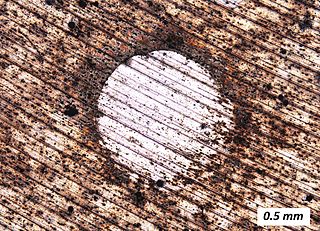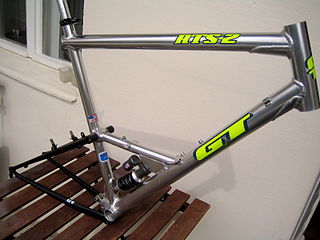Related Research Articles

Aluminium is a chemical element; it has symbol Al and atomic number 13. Aluminium has a density lower than that of other common metals, about one-third that of steel. It has a great affinity towards oxygen, forming a protective layer of oxide on the surface when exposed to air. Aluminium visually resembles silver, both in its color and in its great ability to reflect light. It is soft, nonmagnetic, and ductile. It has one stable isotope, 27Al, which is highly abundant, making aluminium the twelfth-most common element in the universe. The radioactivity of 26Al, a more unstable isotope, leads to it being used in radiometric dating.

Duralumin is a trade name for one of the earliest types of age-hardenable aluminium–copper alloys. The term is a combination of Dürener and aluminium. Its use as a trade name is obsolete. Today the term mainly refers to aluminium-copper alloys, designated as the 2000 series by the international alloy designation system (IADS), as with 2014 and 2024 alloys used in airframe fabrication.
Aluminium–silicon alloys or Silumin is a general name for a group of lightweight, high-strength aluminium alloys based on an aluminum–silicon system (AlSi) that consist predominantly of aluminum - with silicon as the quantitatively most important alloying element. Pure AlSi alloys cannot be hardened, the commonly used alloys AlSiCu and AlSiMg can be hardened. The hardening mechanism corresponds to that of AlCu and AlMgSi.

In materials science, a metal foam is a material or structure consisting of a solid metal with gas-filled pores comprising a large portion of the volume. The pores can be sealed or interconnected. The defining characteristic of metal foams is a high porosity: typically only 5–25% of the volume is the base metal. The strength of the material is due to the square–cube law.

Aluminium recycling is the process in which secondary commercial aluminium is created from scrap or other forms of end-of-life or otherwise unusable aluminium. It involves re-melting the metal, which is cheaper and more energy-efficient than the production of virgin aluminium by electrolysis of alumina (Al2O3) refined from raw bauxite by use of the Bayer and Hall–Héroult processes.

An aluminium alloy (UK/IUPAC) or aluminum alloy is an alloy in which aluminium (Al) is the predominant metal. The typical alloying elements are copper, magnesium, manganese, silicon, tin, nickel and zinc. There are two principal classifications, namely casting alloys and wrought alloys, both of which are further subdivided into the categories heat-treatable and non-heat-treatable. About 85% of aluminium is used for wrought products, for example rolled plate, foils and extrusions. Cast aluminium alloys yield cost-effective products due to the low melting point, although they generally have lower tensile strengths than wrought alloys. The most important cast aluminium alloy system is Al–Si, where the high levels of silicon (4–13%) contribute to give good casting characteristics. Aluminium alloys are widely used in engineering structures and components where light weight or corrosion resistance is required.
Aluminium–lithium alloys are a set of alloys of aluminium and lithium, often also including copper and zirconium. Since lithium is the least dense elemental metal, these alloys are significantly less dense than aluminium. Commercial Al–Li alloys contain up to 2.45% lithium by mass.
6061 aluminium alloy is a precipitation-hardened aluminium alloy, containing magnesium and silicon as its major alloying elements. Originally called "Alloy 61S", it was developed in 1935. It has good mechanical properties, exhibits good weldability, and is very commonly extruded. It is one of the most common alloys of aluminium for general-purpose use.
7075 aluminium alloy (AA7075) is an aluminium alloy with zinc as the primary alloying element. It has excellent mechanical properties and exhibits good ductility, high strength, toughness, and good resistance to fatigue. It is more susceptible to embrittlement than many other aluminium alloys because of microsegregation, but has significantly better corrosion resistance than the alloys from the 2000 series. It is one of the most commonly used aluminium alloys for highly stressed structural applications and has been extensively used in aircraft structural parts.

Alclad is a corrosion-resistant aluminium sheet formed from high-purity aluminium surface layers metallurgically bonded to high-strength aluminium alloy core material. It has a melting point of about 500 °C (932 °F). Alclad is a trademark of Alcoa but the term is also used generically.

The Hiduminium alloys or R.R. alloys are a series of high-strength, high-temperature aluminium alloys, developed for aircraft use by Rolls-Royce ("RR") before World War II. They were manufactured and later developed by High Duty Alloys Ltd. The name Hi-Du-Minium is derived from that of High Duty Aluminium Alloys.
5059 aluminium alloy is an aluminium–magnesium alloy, primarily alloyed with magnesium. It is not strengthened by heat treatment, instead becoming stronger due to strain hardening, or cold mechanical working of the material.
Constellium SE is a global manufacturer of aluminium rolled products, extruded products, and structural parts based on a large variety of advanced alloys. Constellium's C-TEC research center has been credited for advancing technology in the field of advanced aluminium alloy. Constellium primarily serves the aerospace, automotive, and packaging sectors. Large clients include Mercedes-Benz, Audi, BMW, Fiat Chrysler Automotive, Ford, Airbus, Boeing, and Bombardier.
Sustained load cracking, or SLC, is a metallurgical phenomenon that occasionally develops in pressure vessels and structural components under stress for sustained periods of time.
7068 aluminium alloy is one of the strongest commercially available aluminium alloys, with a tensile strength comparable to that of some steels. This material, also known as an aircraft alloy, is heat treatable.
2219 aluminium alloy is an alloy in the wrought aluminium-copper family. It can be heat-treated to produce tempers with higher strength but lower ductility. The aluminium-copper alloys have high strength, but are generally less corrosion resistant and harder to weld than other types of aluminium alloys. To compensate for the lower corrosion resistance, 2219 aluminium can be clad in a commercially pure alloy such as 1050 or painted. This alloy is commonly formed by both extrusion and forging, but is not used in casting.
The Aluminum / aluminum 7049 alloy is a forging aluminum alloy. It has a high stress, corrosion, and cracking resistance and high machinability. Alloy can be hot formed. It can not be weldable.
Aluminium 7050 alloy is a heat treatable alloy. It has high toughness, high strength. It has high stress corrosion cracking resistance. It has electric conductivity of value having 40 percent of copper. 7050 aluminium is known as a commercial aerospace alloy.
7065 is high zinc containing aluminum alloy. It is used for making plate.
Aluminium–copper alloys (AlCu) are aluminium alloys that consist largely of aluminium (Al) and traces of copper (Cu) as the main alloying elements. Important grades also contain additives of magnesium, iron, nickel and silicon, often manganese is also included to increase strength. The main area of application is aircraft construction. The alloys have medium to high strength and can be age hardened. They are both wrought alloy. Also available as cast alloy. Their susceptibility to corrosion and their poor weldability are disadvantageous.
References
- ↑ "Aluminium alloy composition". 29 April 2013. Archived from the original on 2020-10-26.
- 1 2 "Aluminium 5182 mechanical properties". Archived from the original on 2016-11-12.
- 1 2 3 "Applications of Aluminium alloy 5182" (PDF). Archived (PDF) from the original on 2020-12-30.